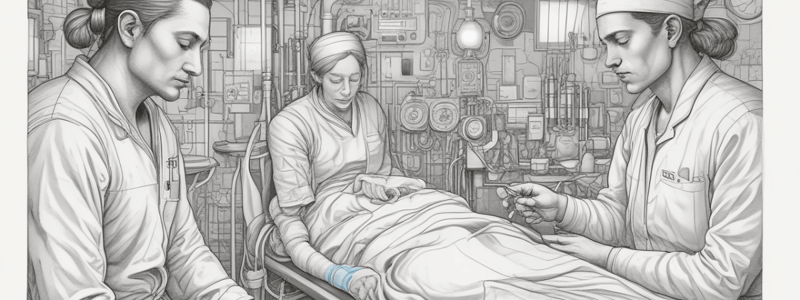Podcast
Questions and Answers
What should be checked in the IV solution before administration to prevent patient harm?
What should be checked in the IV solution before administration to prevent patient harm?
- The brand name of the solution
- The packaging seal
- The presence of air bubbles
- Sediment or discoloration (correct)
Which component helps regulate the number of drops per minute in IV administration?
Which component helps regulate the number of drops per minute in IV administration?
- The regulator
- The trocar
- The drip chamber (correct)
- The extension set
What is the purpose of the stopcock on an extension set?
What is the purpose of the stopcock on an extension set?
- To regulate the temperature of the solution
- To facilitate IV administration without changing primary tubing (correct)
- To filter the solution before it enters the patient
- To connect the IV tubing to the patient
What is the optimal process to prepare the IV solution for use?
What is the optimal process to prepare the IV solution for use?
Which type of IV catheter is most commonly used for adult patients?
Which type of IV catheter is most commonly used for adult patients?
What is true regarding the gauge size of IV needles and catheters?
What is true regarding the gauge size of IV needles and catheters?
What is a common size range for the IV catheter used in healthy adult patients?
What is a common size range for the IV catheter used in healthy adult patients?
What should be done first when preparing the IV solution?
What should be done first when preparing the IV solution?
What is one primary purpose of starting an intravenous (IV) line before anesthesia?
What is one primary purpose of starting an intravenous (IV) line before anesthesia?
Why is it important to close the regulator before connecting to the patient?
Why is it important to close the regulator before connecting to the patient?
Which vein is most commonly selected for IV insertion?
Which vein is most commonly selected for IV insertion?
What is the primary characteristic of the IV solution containers made from plastic?
What is the primary characteristic of the IV solution containers made from plastic?
In which situation would a 14-gauge catheter be most appropriately used?
In which situation would a 14-gauge catheter be most appropriately used?
Which statement best describes the selection of the IV site?
Which statement best describes the selection of the IV site?
What advantage does an IV line provide while a patient receives nothing by mouth?
What advantage does an IV line provide while a patient receives nothing by mouth?
What must be done to glass containers of IV solutions to ensure proper flow?
What must be done to glass containers of IV solutions to ensure proper flow?
Why is it important to avoid inserting the IV in an area that flexes, like the wrist or elbow?
Why is it important to avoid inserting the IV in an area that flexes, like the wrist or elbow?
Which of the following is NOT a function of the IV line in anesthesia?
Which of the following is NOT a function of the IV line in anesthesia?
What is the result of multiplying 100 ml/hr by a drop factor of 20 drops/ml and then dividing by 60?
What is the result of multiplying 100 ml/hr by a drop factor of 20 drops/ml and then dividing by 60?
What is indicated by swelling or discoloration at the IV site?
What is indicated by swelling or discoloration at the IV site?
What is the first step in changing an empty IV solution container?
What is the first step in changing an empty IV solution container?
What should be done if blood backs up in the IV tubing and the solution is not dripping?
What should be done if blood backs up in the IV tubing and the solution is not dripping?
What method can be used to displace air bubbles in the IV tubing?
What method can be used to displace air bubbles in the IV tubing?
What is a crucial step after discontinuing an IV?
What is a crucial step after discontinuing an IV?
Which type of needle insertion angle is recommended for accessing a vein?
Which type of needle insertion angle is recommended for accessing a vein?
How should the catheter be removed from the IV site?
How should the catheter be removed from the IV site?
What should be done if the insertion site is very hairy before preparing the skin?
What should be done if the insertion site is very hairy before preparing the skin?
What could be a potential consequence of attempting an IV procedure without proper training and certification?
What could be a potential consequence of attempting an IV procedure without proper training and certification?
Which of the following options describes the appropriate action after catheter insertion?
Which of the following options describes the appropriate action after catheter insertion?
What should be done if the IV flow is obstructed due to kinking or bending of the catheter?
What should be done if the IV flow is obstructed due to kinking or bending of the catheter?
Which method is least effective for displacing air bubbles in IV tubing?
Which method is least effective for displacing air bubbles in IV tubing?
What type of dressing is used to secure the catheter to the skin?
What type of dressing is used to secure the catheter to the skin?
What is critical to do once the needle has been removed from the catheter?
What is critical to do once the needle has been removed from the catheter?
What is the purpose of a tourniquet during IV insertion?
What is the purpose of a tourniquet during IV insertion?
Which factor determines the specific methods used to start and secure an IV?
Which factor determines the specific methods used to start and secure an IV?
What should be done with the catheter package label once the catheter is inserted?
What should be done with the catheter package label once the catheter is inserted?
Which gauge needle is typically used in conjunction with a 1-3 cc syringe for local anesthetic?
Which gauge needle is typically used in conjunction with a 1-3 cc syringe for local anesthetic?
What indicates that the catheter has been properly placed after insertion?
What indicates that the catheter has been properly placed after insertion?
What is the primary reason for covering the patient with a warm blanket?
What is the primary reason for covering the patient with a warm blanket?
Which action is inappropriate when assisting a patient who needs to void?
Which action is inappropriate when assisting a patient who needs to void?
What is the role of the weighted precordial stethoscope during surgery?
What is the role of the weighted precordial stethoscope during surgery?
Why should the solution container of an IV not be allowed to fall or run dry?
Why should the solution container of an IV not be allowed to fall or run dry?
What should be done if a patient feels nauseous or light-headed during preparation?
What should be done if a patient feels nauseous or light-headed during preparation?
What is the importance of maintaining the patient's privacy during surgery preparation?
What is the importance of maintaining the patient's privacy during surgery preparation?
Which equipment is crucial for monitoring the patient during the induction phase?
Which equipment is crucial for monitoring the patient during the induction phase?
How should a caregiver communicate with a patient before surgery?
How should a caregiver communicate with a patient before surgery?
Flashcards are hidden until you start studying
Study Notes
Intravenous (IV) Line Preparation
- Starting an IV is an essential first step in preparing patients for anesthesia, either performed directly or assisted by anesthesia personnel.
- IV fluids are crucial for supplementing or replacing lost body fluids before, during, and after surgery.
- The IV line facilitates fluid replacement while the patient is NPO (nothing by mouth) and allows for controlled administration of medications.
IV Line Selection and Insertion
- Common insertion sites include the nondominant hand’s metacarpal vein, chosen for size and accessibility.
- Insertions should avoid areas that may flex, such as the wrist or elbow, to prevent catheter obstruction.
- Rigid steel needles, over-the-needle catheters, butterfly needles, central veins, and cutdown catheters are types of IV devices used based on the patient and procedure.
Solution Containers and Administration
- IV solutions are stored in plastic bags, bottles, or occasionally glass containers; bags collapse while being infused, requiring venting in bottles.
- Solutions must be inspected for sediment or discoloration prior to administration.
- Sterile, disposable IV tubing connects the solution container to the patient's IV catheter, with components that help regulate flow.
IV Procedure Steps
- Preparation: Position the patient comfortably, use a tourniquet to distend veins, and cleanse the site with an antiseptic. Local anesthetic may be injected for comfort.
- Insertion: Insert the catheter needle at a 30° to 45° angle. Observe for blood return, indicating proper placement in the vein, then secure the catheter.
- Securing the Catheter: Use a secure dressing and label the catheter site with pertinent information such as initials, date, and time.
Monitoring and Maintenance
- Solution flow and rate are regulated according to physician's orders, with adjustments made based on the drop factor of the administration set.
- Ensure IV site remains free from swelling or discoloration, alerting the anesthetist if issues arise.
- Manage air bubbles carefully to prevent air embolism; various techniques may be used to clear bubbles from the line.
Discontinuing the IV
- To discontinue, prepare by clamping the tubing, removing the dressing swiftly, and applying pressure to the insertion site to prevent bleeding.
- Record the time and total fluid administered, noting any patient reactions.
Additional Preanesthetic Responsibilities
- Ensure patient comfort and warmth, monitor their condition, and assist with transferring to the operating table.
- Keep emergency supplies accessible, such as oxygen and emesis basin, while supporting the patient emotionally through explanations and hand-holding.
- Assist with attaching monitors like blood pressure cuffs, ECG, and pulse oximeters prior to induction.
Safety and Protocols
- Always follow local policies regarding IV procedures, ensuring proper training and guidelines are adhered to.
- Maintain patient dignity and privacy throughout the preoperative process.
Studying That Suits You
Use AI to generate personalized quizzes and flashcards to suit your learning preferences.




